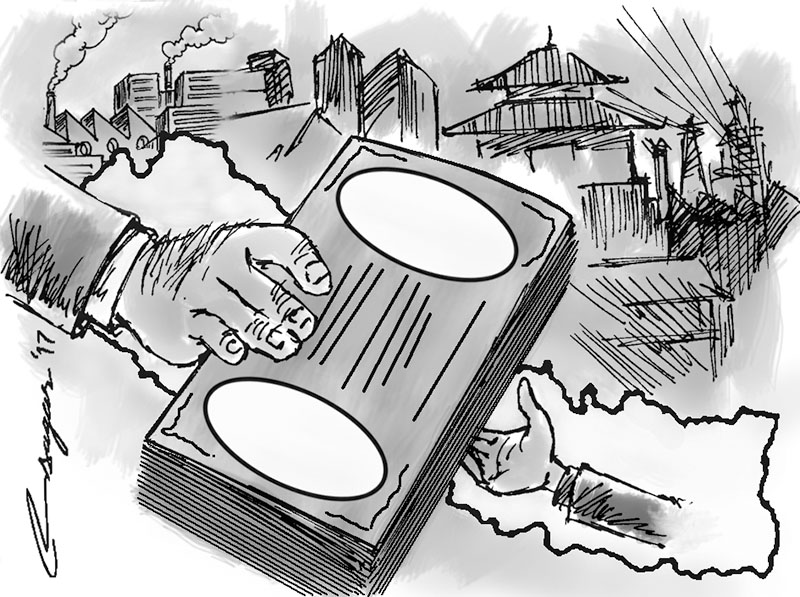Use of foreign aid: Many questions
The flow of foreign aid augurs poverty and economic burden. Late reports point that 70% of aid ends in providing salaries and only 30% goes to the field. The highest salary drawing personnel come from the host countries themselves
As the entire world has shrunk into a small village due to technological advancement, the interconnectedness and beyond border attachment of people are inexplicably high and stronger than ever imagined. Besides assuring personal prosperity, sharing gains and pains together and collectively venturing to make this world as the most elegant place to live in is the target of such mobility. But at a time when a part of world is enjoying magical material advancement and lavish living, many people around the globe are suffering miserable lives with acute shortage of basic needs like food, health, education, developmental infrastructure and so on.
In sequel, people have started sensing their duty throughout the globe. Despite having nationality as an identity’s component, global citizenry and global responsibility are also acknowledged. With good sense many people are working to evacuate the people and help them. But every individual can’t always afford and extend such pious help to the needy people despite having a desperate will to do so. Thus, governments and various missions or organizations from different countries are coordinating such efforts. Interchangeably synonymous terms -- foreign aid, diplomatic assistance and humanitarian help -- are used to indicate the missions.
The concept of foreign aid emerged with America-initiated Marshal Plan in the 1940’s to evacuate the Second World War-torn west Europe’s economy and development. Nepal commenced receiving such help in 1952 with an education based Colombo plan. Now, dense existence of many non-governmental and international nongovernmental institutions known as NGOs and INGOs around the country is common. More than ten thousand such organizations are channelizing various sorts of foreign aid to different sectors. Statistics reveal that the foreign aid in 1954 was 1.56 American dollar per person but now it is plus 300 dollars. With a 200 fold jump in the past 6o years, the figure comes to around 30% of the budget and 60% of the total development budget. Every Nepali has a loan equal to 13,226 Nepalese rupees.
The aid making agencies often brag of providing humanitarian assistance but outputs rarely reflect this. This is similar in Nepal too. Though it was wholeheartedly accepted and fully respected sans any reservation for long, there are barely solved thick suspicions these days. Foreign aid has sufficiently and ruthlessly posed serious deceleration on economic progress, human rights, internal adjustment, solidarity and many more aspects of donation receiving countries. With obnoxiously negative impacts of such aid, economic productivity of the people has been impeded beyond narration. Dependencies and laziness are rife; corruption has gained new speed. Factories are closed and the hard-working nature of people is rusted. People demand development with others. Degradation of caliber is unchecked.
These organizations often have good works on paper but the reality is barely so. Following the national crisis with a 7.8 mega quake in Nepal 2015, Dhurmus Suntali Foundation built 75 houses for integrated settlement with an investment of Rs. 5.4 corers in Girinchaur. But various NGOs and INGOs have been reported spending 10 times more in the same district for nothing tangible.
The flow of foreign aid augurs poverty and economic burden. Late reports point that 70% of aid ends in providing salaries and only 30% goes to the field. The highest salary drawing personnel come from the host countries themselves. But the total sum accumulates in loans to receiving nations. Besides, unfairly, many nations are providing aid for military enhancement. As a result, this has killed many innocent people. Even in Nepal, various malpractices of those providing aid are noticed. They regularly enforce conversion. The point of crookedness was when some earthquake victims were distributed expired foods. Racial confrontation, ethnic fueling, communal cacophonies, and cabinet shuffling are gaining ground.
George Massion’s book ‘Doing Bad by Doing Good’ reveals the gross side-effects of foreign aid. Extension of the West’s hegemony and advertising of pseudo humanism are the appalling outcomes. Damsia Moyo’s ‘Dead Aid’ infallibly highlights that guests supply slow-poison to sabotage the possible organic model of development to other nations. Africa has received one trillion dollars till now but situation there is more exacerbated. Under the banner of aid, the manner of exploiting other nations’ rare resources is also practiced often. Cross border surveillance and spying are reported. Exerting hegemony and imposing the unsolicited superiority complex on helping have always been an ugly outcome. Aid receiving countries’ citizens often reel with psychological unrest and sense of humiliation. Aid is not helping much in developing, and it is harming the receiving nations.
Thus, many nations have started adopting a pushback trend policy to resist and restrict such foreign aid. China, Zimbabwe, Pakistan and many others have tried to do so. A year back, international relations and labour committee of our parliament had enjoined the government to formulate a rational and reasonable policy to systematize foreign aid. Speedy efforts on it are needed as foreign aid has raised national questions.
Dahal is a PhD on issues of nation building






